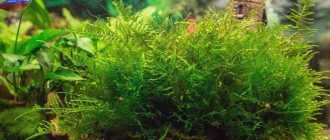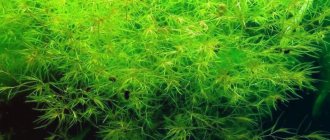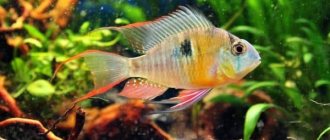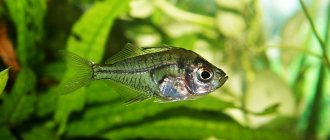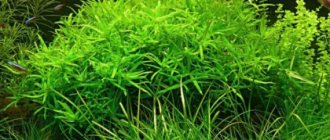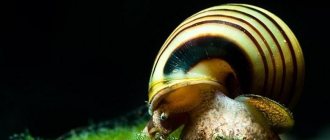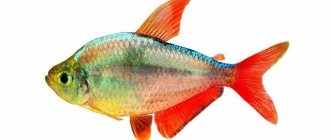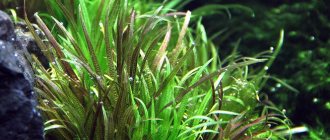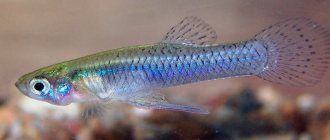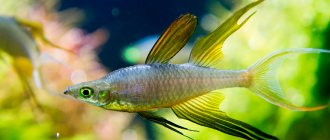DESCRIPTION
Bolbitis Gedeloti or water fern is a beautiful plant that is very popular among aquarists. Found in the wild throughout Africa. He loves to live in fast-flowing rivers. It grows on snags and stones, clinging to them with its roots. This allows it to stay in place despite the fast current. It is extremely rare to find it on bare ground.
This is a spectacular, bright, attention-grabbing plant. Its creeping green-black roots covered with scales, entwining everything around, look very decorative. And the long carved, bright green leaves, the tops of which rise above the water, are not inferior to them in their expressiveness. All this makes an unforgettable impression on lovers of underwater flora.
For a long time now , Bolbitis Gedeloti, thanks to its versatility and spectacular appearance, has become a permanent resident of temperate and tropical aquariums. It is used as a background plant in an aquarium where it looks perfect. Despite its versatility and ease of care, it is still necessary to adhere to certain rules when growing it.
BOLBITIS GEDELOTI
Features and appearance
Bolbitis fern spreads horizontally. Its length is limited only by the walls of the aquarium in which it is planted. The cross section of the stem reaches 10–12 mm. The root system is attached to decorative elements, substrate and stones that are present in the tank.
The fern in the Bolbitis aquarium is covered with special plates. From each stem comes a fringe, green leaves, and roots. The algae leaves look like oak leaves. Its structure resembles a grid.
The density of Bolbitis is higher than the density of aquarium water. Therefore, the algae is located at the bottom of the tank.
In aquarium conditions, the plant reaches a length of 25–35 cm.
Watch the video of what a fern looks like in an aquarium.
Use in aquadesign
The bush is used to decorate aquariums. Place it in the background. In such a place it forms a green background, reminiscent of a dense forest. This allows plants of pale shades to look more advantageous in the foreground. Dense thickets provide shelter for viviparous fish and shrimp.
Thanks to its compact size and carved leaves, the fern will look impressive on a single stone or snag. When placed in the center of the aquarium, you can create a fantastic decor. By varying the height of the bush and its location, you can create a triangular or U-shaped landscape, as well as an “island”.
Bookmarks 0
Reproduction
There is no exact data on the reproduction of Bolbitis gedeloti. In the wild, reproduction is accomplished by spores. They appear on the leaves of old plants.
The aquarium plant gedeloti bolbitis is propagated artificially. To do this, carefully disconnect a section from the root stem. This procedure is performed carefully. After all, inaccuracies contribute to the death of shoots.
Dividing the root system is done using a scalpel. The procedure is carried out in water. The cut area should contain 3-4 leaves. The sections are treated with ground activated carbon. The segments are concentrated between stones and snags. You cannot sprinkle the roots with substrate. The description of the process is familiarized with in advance.
Content
- 1 Description
- 2 Conditions of detention
- 3 Lighting
- 4 Ground
- 5 Features
- 6 Reproduction
- Other names: Bolbitis heudelotii, Congo fern.
- Origin: Africa.
- Size: height up to 50 cm.
- Temperature: 22-28 °C.
- Water parameters: pH 5.7–7, dKH 2–11 °.
- Lighting: 0.3 W/l.
- Growth rate: slow.
- Additional information: place on the decor.
- Content complexity: complex.
Aquarium water
Keeping ferns in an aquarium is an interesting and complex process. Special requirements apply to water.
Temperature
The ideal temperature is 22–25 degrees. Therefore, Bolbitis is planted in containers with viviparous phenotypes, heat-loving algae. Vegetation tolerates temperature drops of up to 20 degrees normally. Cold water has a detrimental effect on the condition of the root system and leaves.
Compound
To maintain the shield insect, clean water is required. The concentration of nitrates in the liquid should be minimal. Therefore, containers with ferns are equipped with mechanical filters.
The hardness of aquarium water should not exceed 7–8. If this indicator increases too much, the leaves and stems are destroyed. The acidity level must be monitored. To stabilize these indicators, appropriate units are used.
Changing water
Water changes (about 25–30 percent) help maintain chemical parameters. For replacement, use soft, pre-boiled and settled water. The boiling process allows you to remove salts, chlorine, and other harmful components.
Tap water is not used to maintain algae. After all, the death of the root system is not excluded when using chlorinated or salted liquid.
Lighting Features
Dwarf algae develops in different lighting conditions. For these plants, diffuse light or a powerful light beam is created.
Direct rays are not allowed. After all, they provoke the spread of green algae, which have a detrimental effect on the condition of the fern and spoil its root system.
For lighting, experienced aquarists use medium-power fluorescent lamps. Daylight hours are 11–12 hours. The exact period is set taking into account what plants are planted in the aquarium and what fish phenotypes are present.
Aquascaping
The aquarium plant bright bolbitis is used by some aquarists to create lively pictures. Ferns are used to fill in uneven areas and create forests in underwater worlds.
Ferns are also used to fill areas at various levels. At the same time, the leaves remain dark green.
Bolbitis fern is used by aquarists in freshwater tanks, large and small aquariums. They are compatible with shellfish, viviparous and spawning fish phenotypes. With their help, they create ideal conditions for breeding fish and raising fry.
Video about bolbitis fern
AdminAuthor of the article
Did you like the article?
Share with your friends:
Congo fern or Bolbitis gedeloti
Homeland - West African tropics from Angola to Guinea. Distributed in slow-flowing rivers and along the banks of reservoirs.
The Bolbitis heudelotii fern or Congo fern reaches sizes up to 30 cm in height. The rhizome is creeping, fibrous with scales. The leaves are complex, hard, deeply dissected. They have a green color. The plant is very popular among aquarists.
Bolbitis gedeloti or Congo fern photo
Comfortable water parameters for keeping Bolbitis : 24-26°C, hardness 3-5°, pH 6.8-7. Lighting should be moderate. The fern should be kept in water with a slightly acidic environment (pH 6-7), since the leaves of the plant tend to dissolve quickly in alkaline water. The water hardness in the aquarium is about kH 6° - the maximum permissible. Congo fern needs to be regularly fed with fertilizers, especially if the soil is not nutritious. The supply of CO2 is not necessary, but is desirable for rapid growth and good plant habit. Bolbitis gedeloti can grow not only in the substrate. Its rhizoid rhizomes grip any hard surface: stones, driftwood, and other decor.
Bolbitis Gendelot or Congo fern photo
Bolbitis Gendelot or Congo fern photo
This fern, Bolbitis gedeloti, develops well if you monitor the condition of the water in the aquarium - every week you need to replace 20% of the water with clean water. Filtration and aeration must be required.
The plant is a fern, easily propagated vegetatively by dividing the rhizome. The separated pieces should have 2-3 leaves.
Cool videos about plants from FanFishki
Subscribe to our YouTube channel so you don't miss anything
PRACTICAL NOTE ON GROWING AQUARIUM PLANTS
This note is posted in all FanFishka articles dedicated to aquarium plants. This is a cheat sheet with a link that will help you grow any aquarium plant and herbalist of any complexity.
Most of the reference materials are located in the Aquascape , we also recommend our brochure: Aquarium navigator for beginners: “Underwater Gardens of Babylon” .
The formula for success in growing plants can be depicted as follows.
First of all, the proper level of lighting is necessary.
(light intensity - Lumens)
Next, the proper concentration of CO2
Further macro-fertilizers and micro-fertilizers
Water parameters, care and quality water changes
The gradation of this formula is based on the degree of importance. Lighting intensity is primary, and then descending. Therefore, if your plants have holes in the leaves, they have sciatica (crooked) or there are problems with algae, then please do not read the “bad advice” - this is chlorosis (lack of iron), this is a lack of potassium... diarrhea, phimosis and endometriosis )
You always need to solve the problem of setting up an herbalist from major to minor. Plants will die more quickly from a lack of lighting than from a lack of Fe and K. Moreover, the latter are always present in one degree or another in the aquarium, but it is difficult to measure their precise value.
Below, let's go from the main to the minor.
Lighting in an aquarium with plants . Remember, the most important thing in light is its intensity (Lumens)! All other lighting characteristics: spectrum, Kelvin, PAR/PAR, Ra... are important, but secondary. There will be no intensity of lighting, there will be nothing. At the same time, the lighting intensity must be balanced - selected specifically for your project (height of the water column, number and types of plants, daylight hours).
Based on the above, choose aquarium lighting primarily by the number of lumens, and then everything else.
Lighting is the most expensive part. The most budget-friendly solution is to install ordinary construction-street floodlights above the aquarium . Fortunately, they are now very thin and aesthetic. And believe me, under them everything grows with a bang, of course, provided that all the other components are present.
In order not to be unfounded, here are photos of our herbalists, which were grown exclusively under LED spotlights or with their presence.
If you want professional lighting or aesthetics. Then you will have to fork out some money. The amounts can vary quickly from 10,000 to 50,000+ rubles for a 100 liter aquarium. For example, in 2021 we switched to professional lighting - ISTA Titan . Yes, not cheap, but the lamps are Achon! We have grown a professional competitive aquascape under them. That’s why we advise you to pay attention to them.
Well, it’s difficult to advise anything, because... Everyone has different needs and capabilities. In this article we talk about the products of our partners - Tetra , Laguna , ISTA lighting .
We tried to briefly and objectively talk about them. Then it's up to you. In any case, we do not really recommend that you pay attention to handicraft lighting assembly from folk craftsmen. Not all, but as a rule, they shove who knows what kind of diodes into such an assembly, assemble it all on their knees... and believe me, more than once on the forum you hear echoes of the consequences of such a purchase. After all, a company is a company. At a minimum, you are given warranty and post-warranty service.
If you are a beginner, your first herbalist, then LED spotlights are your choice. Let's move on, otherwise this note isn't very short =)
CO2 for aquarium plants . The plant is approximately 90% water, the remaining 10% is dry matter. Of that 10%, 46% is carbon. This is why CO2 supply is so important in a planted aquarium.
Plants in an aquarium obtain carbon “from water” - from carbon-containing compounds. But the natural concentration of C-carbon in water is small and is only sufficient for unpretentious plants, but they, and even more so, will be happy with additional carbon feeding. The supply of CO2 can be provided using mash or a CO2 balloon system , lemon juice or other methods.
The best, professional, simple and budget option is to supply carbon dioxide through a cylinder. One thing, however, is the initial purchase of a set: a cylinder, an MG valve, a diffuser…. will hit the budget.
Is it possible to do without CO2, but for a couple of bushes of simple plants ( cryptocorynes , echinodorus , most ludwigias , etc.).
What balloon systems can you recommend? The most budget option is an assembly from craftsmen who sell CO2 systems in VK and on forums. Everything is very high quality.
If you want a branded item, then we recommend the most inexpensive and at the same time high-quality CO2 systems from ISTA (Taiwan) . We have been using them for 5 years and recommend them to you.
On sale you will find two series of ISTA Aluminum CO2 Cylinder cylinders, with horizontal and vertical threads of 1 and 3 liters.
Fertilizers for an aquarium with plants . All fertilizers, of any brand, can be divided into MACRO-FERTILIZERS and MICRO-FERTILIZERS .
Macro fertilizers are nitrate NO3 and phosphate PO4 from which plants take N-nitrogen and P-phosphorus. These are the most important elements after CO2 - C-carbon.
Remember - Redfield's proportion rules . Always keep it under control and everything will be ok. Right, based on our observations, Redfield’s proportion rules only in full NPC proportions. Incomplete proportion - without carbon C does not give good results.
Micro fertilizers . These are all the other less important elements that are necessary for plants (see link). There is no point in putting too much emphasis on them. Firstly, all of them are contained in one quantity or another in tap water and are restored in the aquarium with changes. Secondly, an overdose of micro very quickly leads to an outbreak of algae.
A common mistake made by beginners is not understanding what they are pouring into the aquarium. For example, let's take such a popular and popular fertilizer as Tetra PlantaMin . Read the product summary at the link - it strengthens, stimulates, and gives a chic body shape.
A beginner, without delving into the essence, uses it and gets an outbreak of algae, writes on the forums - “Like, wow, what a bad Tetra.” And the trouble lies not in the drug, but in a lack of understanding of the nitrogen cycle and balance in the herbalist . The beginner has a Redfield bias (let’s say N and P are generally zero) and instead of making up for the lack of these primary elements, he fills the aquarium with Tetra PlantaMin - a micro-fertilizer (iron, potassium, manganese). As a result, going over the micro is only detrimental, because... plants lack the base - nitrogen and phosphorus.
Thus, you must understand what plants lack and understand fertilizers.
How to understand what plants lack? It's simple. Now the market is filled with a variety of expensive and not so expensive aquarium water tests. We recommend inexpensive domestic ones - VladOx drop tests , they are sold online and offline.
We also recommend, let’s not be afraid of this word, innovative domestic UHE tests . They are currently only sold online.
The minimum set of tests for an herbalist is NO3 and PO4. It is advisable to have the entire nitrogen range: NH4, NO2, NO3. As well as kH and pH tests.
Tests help us monitor the situation in the herbalist, but over time it is advisable to learn to see and feel the aquarium for yourself. With experience you need to move away from “convulsive testing”; the best aquarium test and tool is ourselves.
Let's summarize this part. Macro, it’s macro in Africa too. The link above generally contains a recipe on how to make them yourself. If you are not yet ready for self-mixing, then always and everywhere you will find a line of fertilizers from Tetra: Tetra Planta Macro , Tetra PlantaMicro , substrates, root tablets and much more .
Of course, there are many other brands that produce aquarium fertilizers. There is an opportunity, use even ADA products. All markers are different in taste and color. The main thing is to use it with a clear understanding of what you are using it for and what you want to get in the end.
From the professional line of fertilizers, at an adequate price, we can recommend Prodibo (soils, soils, macro, micro, stimulants, etc.).
So, something like a note turns into the Talmud. Which is not surprising - the topic is very broad. One moment left.
Water parameters for aquarium plants. Link1 and Link2 , please look at these articles, they cover the essence quite well.
Here we note that the quality of photosynthesis is influenced by the process of caring for the aquarium: water parameters (kH, pH below 7), high-quality filtration and aeration, competent and timely water changes.
Please study
